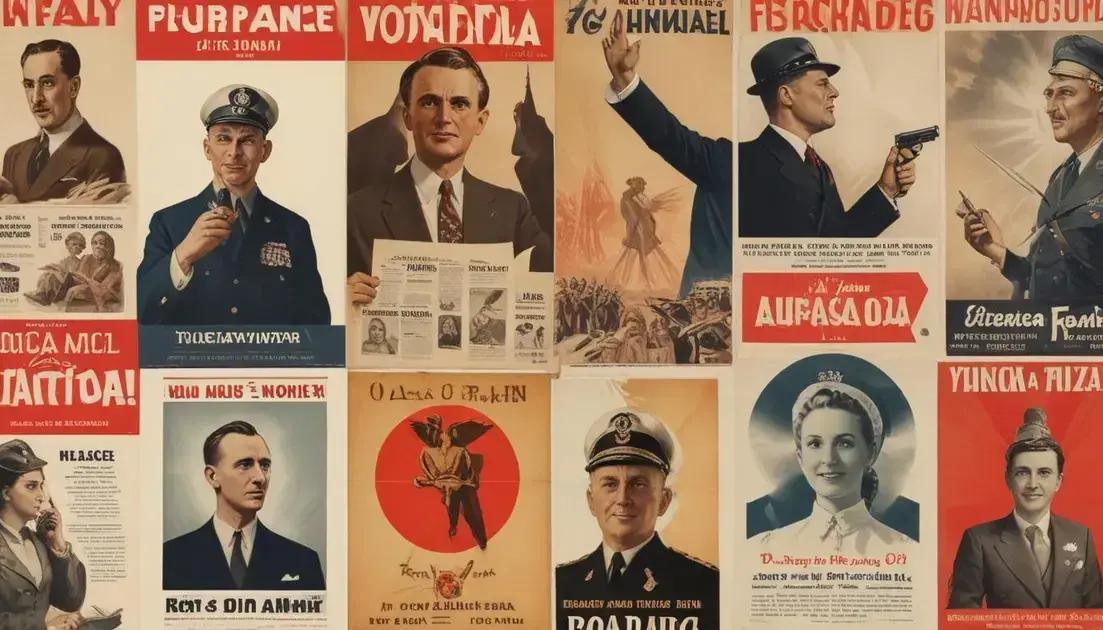
The art of persuasion: propaganda through design
Propaganda utilizes strategic design and psychological principles to shape opinions and influence behavior. Effective messaging relies on clear visuals, emotional appeals, and credible sources. Understanding the historical context of propaganda alongside modern examples helps recognize its powerful impact in our digital age, where social media and advertising play vital roles. To create successful designs, keep them simple, use readable fonts, and select appropriate colors that align with the message.
Welcome to the exploration of propaganda in design! From historical roots to modern implications, let’s uncover how visuals shape our perceptions. Ever wondered how a simple image can sway opinions?
The Historical Context of Propaganda
Propaganda has been a significant part of history. It shapes opinions and influences behaviors. From the ancient times of the Egyptians to modern society, propaganda has evolved in form and function.
Early Uses of Propaganda
In ancient Egypt, rulers used images and symbols to promote their achievements. They depicted themselves as strong and divine. This simple but effective method spread their influence among the people.
World War I and II
During World Wars I and II, propaganda took center stage. Governments used posters and films to rally support. They aimed to inspire patriotism and encourage enlistment in the military.
The Rise of Mass Media
The rise of radio and television changed how propaganda was delivered. It reached broader audiences with powerful messages. This era saw propaganda move beyond simple images to include compelling stories.
Propaganda in Modern Times
Today, social media is a major platform for propaganda. Governments and organizations use viral content to sway public opinion. Images and videos circulate quickly, making it easy for messages to spread.
Understanding the historical context of propaganda helps us see its role in today’s world. Recognizing its roots in art and media can aid us in critical thinking when we encounter various messages.
The Power of Visual Design
Visual design is key when it comes to propaganda. It grabs attention and communicates messages quickly. Our brains process images much faster than words. This is why visuals are so impactful.
Color Choices Matter
The colors used in design can affect our feelings. For instance, red can convey urgency. Blue often represents trust. Understanding color psychology helps creators design more effective propaganda.
Typography’s Role
The type of font can change how a message is perceived. Bold fonts can make statements stronger. A softer font might seem friendly and approachable. Choosing the right typography is essential for clear communication.
Imagery and Symbols
Images and symbols can tell stories without words. For example, a dove can symbolize peace. A raised fist often represents strength and resistance. Using relatable symbols makes messages more powerful.
Layout and Composition
How a design is laid out also impacts its effectiveness. Good composition guides the viewer’s eye. It helps them understand the message at a glance. Clear hierarchy in design leads to better comprehension.
In propaganda, visual design is not just art. It’s a strategic way to influence thoughts and behaviors. By understanding its power, creators can craft compelling messages that resonate.
Modern Examples of Propaganda
Modern propaganda is everywhere, especially in our digital world. It’s not just old-school posters anymore. Today, social media platforms play a huge role.
Social Media Campaigns
Many organizations use social media to spread their messages. Campaigns can go viral, reaching millions quickly. Think of hashtags that raise awareness for causes. These campaigns are often carefully crafted to influence opinions.
Advertising as Propaganda
Advertising can be seen as a form of propaganda. Brands create ads that appeal to emotions. They want you to feel something about a product, making you more likely to buy it.
Documentaries and Films
Films and documentaries can be powerful propaganda tools. They often present a specific viewpoint. By telling a story, they shape how audiences think about issues. This influence can be strong.
News Organizations
Even news media can act as a source of propaganda. Different outlets may present the same event in different ways. The angle they choose affects public perception.
Recognizing modern examples of propaganda helps us stay aware. It encourages us to think critically about the information we consume every day.
The Psychological Aspects of Persuasion
The psychological aspects of persuasion are fascinating. Understanding how people think can help create effective propaganda. It’s all about appealing to emotions and thoughts.
Emotional Appeals
Emotions play a big role in decision-making. When propaganda touches feelings, it sticks. Happy images may inspire joy, while sad ones can evoke sympathy.
Social Proof
People often look to others for guidance. This is called social proof. Showing that others support a cause can influence people to join in. When they see friends involved, they feel more comfortable participating.
Scarcity and Urgency
Creating a sense of scarcity can drive action. If something seems rare or limited, people often want it more. For example, ads may say, “Only available for a short time!” This pushes individuals to act quickly.
Authority and Trust
Trust is essential to persuasion. If a respected figure supports a message, it’s more convincing. People are more likely to believe information from credible sources.
By using these psychological tricks, propaganda can effectively convince and persuade. Knowing how to tap into these aspects can help create messages that resonate deeply with audiences.
Design Tips for Effective Messaging
Effective messaging relies heavily on design. A well-designed message grabs attention and makes an impact. Here are some tips to enhance your designs.
Keep It Simple
Simple designs are easier to understand. Avoid clutter and focus on one key idea. This helps the audience quickly grasp your message.
Use Clear Fonts
The fonts you choose matter. Use clear, readable fonts to ensure everyone understands your text. Avoid using too many different fonts in one design.
Choose the Right Colors
Colors can set the mood. Use colors that match your message. Warm colors like red can create excitement, while cool colors like blue can calm.
Include Images Wisely
Images should support your message, not distract from it. Use high-quality images relevant to your content. They can help evoke emotions and reinforce your idea.
Make It Interactive
Interactive designs can engage viewers. Incorporate elements like polls or quizzes to draw people in. This makes them more likely to remember your message.
By following these design tips, you can create effective messages that resonate with your audience. Strong visuals combined with clear writing lead to better communication.
Conclusion
In conclusion, understanding propaganda and its design elements is crucial in today’s world. By exploring the historical context and modern examples, we can see how it shapes opinions. The psychological aspects of persuasion and effective messaging play significant roles in communication.
Adopting the right design tips can enhance your messaging, making it more impactful. Simple designs, clear fonts, and appropriate colors can draw in your audience and make your ideas stick. Remember, the goal of effective propaganda is not just to inform but also to influence and inspire action.
As you create your messages, keep these strategies in mind. This will help you connect with your audience better and make your ideas resonate more strongly.


